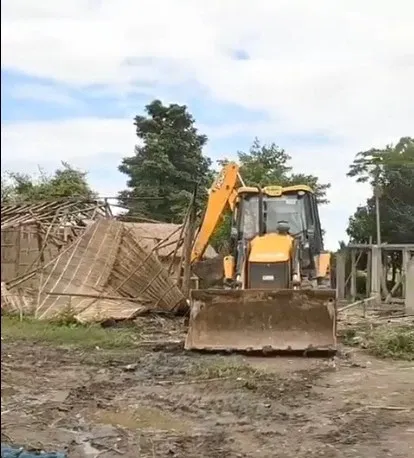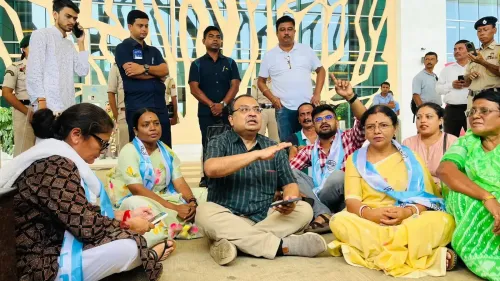How Did Assam Recover 1,200 Hectares of Forest Land from Encroachment?

Synopsis
Key Takeaways
- 1,200 hectares of forest land reclaimed in Golaghat.
- Phase I of the eviction drive completed.
- Nearly 2,000 families evicted from the Rengma Reserve Forest.
- Significant police presence ensured the eviction process.
- Continued efforts to address illegal land occupation.
Guwahati, Aug 4 (NationPress) The Chief Minister of Assam, Himanta Biswa Sarma, announced on Monday that the initial phase of the eviction operation in the Rengma Reserve Forest at Uriamghat in the Golaghat district has concluded successfully, with over 1,200 hectares of land now cleared of encroachments.
In a statement shared on the social media platform X, CM Sarma expressed, "The first phase of the eviction operation in Uriamghat is complete, during which we reclaimed more than 1200 hectares of land in the Rengma Reserve Forest."
He further cautioned that the eviction efforts would persist across the state to eliminate illegal encroachments.
"This initiative will continue both here and throughout the state to reclaim every square inch of land that rightfully belongs to the residents of Assam," CM Sarma stated.
Last week, the state administration from Golaghat initiated a massive eviction drive.
During this operation, nearly 2,000 families accused of encroaching upon the forest land within the Rengma Reserve Forest in the Sarupathar sub-division were forced to vacate the area.
The land in question, which had allegedly been transformed into betel nut plantations connected to a broader "betel mafia" network, has faced stringent administrative measures following extensive land surveys conducted across 30 villages in the vicinity.
To support the eviction, authorities dispatched a strong contingent of approximately 700 to 800 personnel from the Assam Police, Central Reserve Police Force (CRPF), and the State Forest Department.
Heavy machinery, such as bulldozers and excavators, was also brought in to facilitate the eviction process.
Among those facing eviction are predominantly Bengali-speaking Muslims, a community often labeled as illegal immigrants from Bangladesh.
Reports indicate that many individuals have fled the area in fear, seeking refuge in other regions of Assam.
Official estimates reveal that over the past four years, 1.29 lakh bighas (around 42,500 acres) have been reclaimed from encroachments; however, nearly 29 lakh bighas (more than 9.5 lakh acres) still remain under illegal occupation across the state.
The state government has asserted that many encroachers hail from Muslim-majority districts within Assam, including Nagaon, Morigaon, Sonitpur, Cachar, Dhubri, Barpeta, and Hojai, as well as neighboring states like West Bengal and Bihar.
As tensions escalate, the government of Nagaland has issued an advisory urging border districts to remain alert and prevent any influx of displaced families from Assam into its territory during the eviction process.









